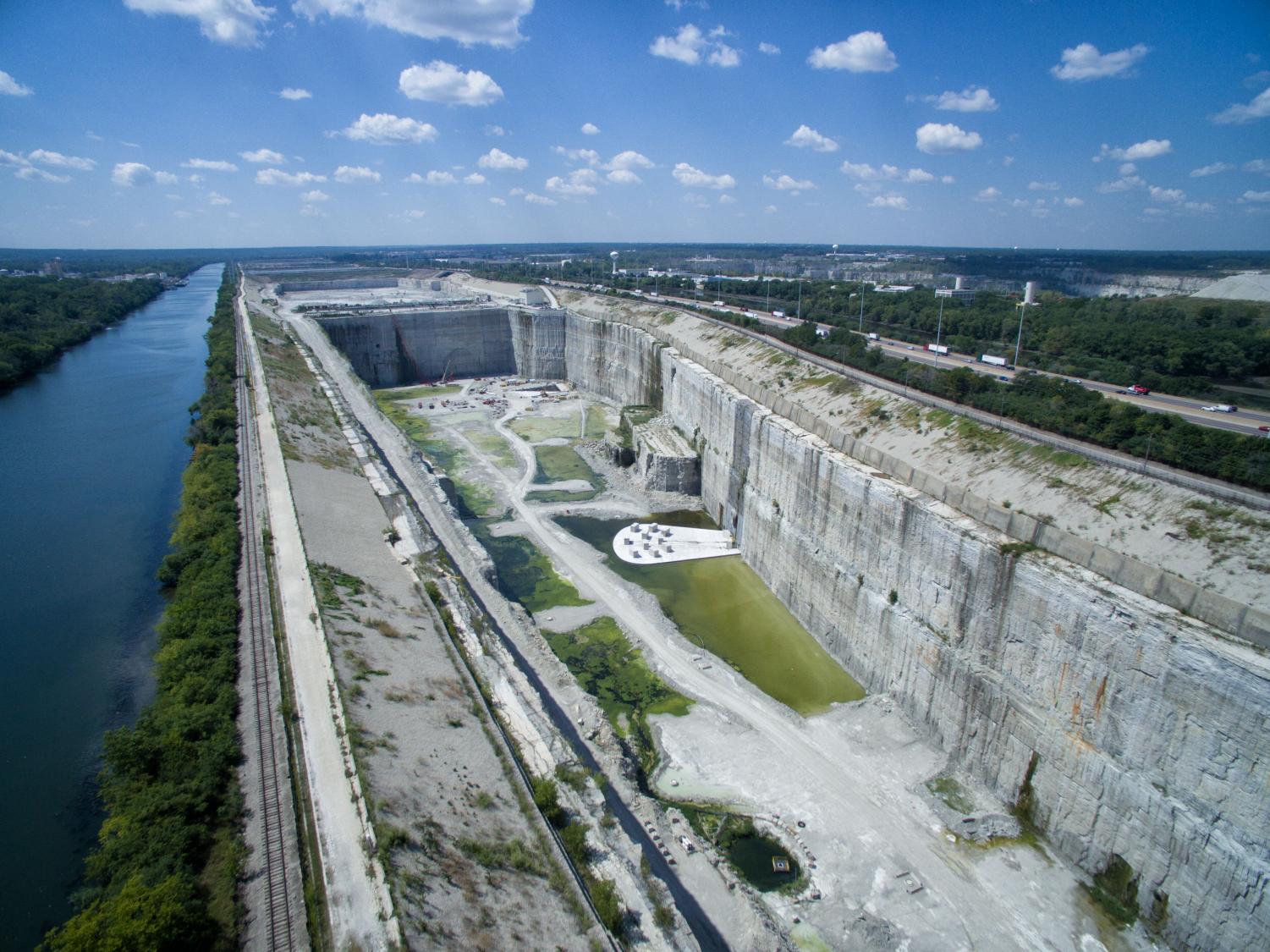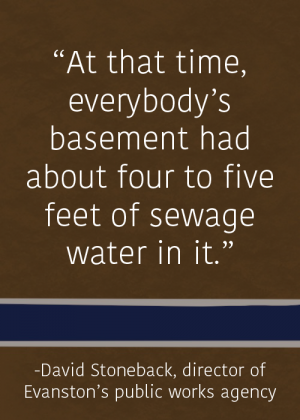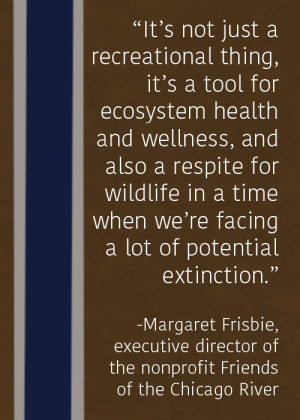In Focus: As climate change worsens, combined sewers pose new issues
May 26, 2020
Evanston’s sewer system has been flooded with problems for decades.
As early as 1902, the city’s commissioner of public works declared the sewer system to be “inadequate in size and depth to serve the demands of the city.” Almost a century later, Evanston City Council approved a program in 1990, revamping the sewer system to reduce property damage created when sewage backed up into residents’ basements.
And, now, the sewer system is featured in the city’s Climate Action and Resilience Plan as an area to improve as the threat of climate change in Chicagoland grows. According to CARP, scientific data suggests climate change could increase the number and impact of damaging floods.
Such floods could lead to sewage backups known as combined sewer overflows, or CSOs — times when stormwater overwhelms the sewage treatment system. When the sewer system gets overwhelmed, untreated wastewater can get released into Lake Michigan or the Chicago River, causing environmental damage and numerous potential public health hazards, such as contaminated drinking water.
While the city has taken numerous steps to combat CSOs, City Council in April awarded a contract for a stormwater analysis of Evanston, through which staff hope to find where rainwater poses the most potential damage to the city. From there, Evanston can move forward to fix any issues or further prevent damage caused by storms — though climate change and the area’s history are pressuring the timeline.
Fixing the leaky pipes
Evanston’s combined sewer system developed alongside the city, meaning most of the system is between 80 and 100 years old, according to the city’s website. The entire city is served by this combined sewer system, with a Metropolitan Water Reclamation District of Greater Chicago treatment plant located in the south side of the city.
Pipes a foot or less in diameter make up 60 percent of the city’s 144 miles of combined sewers. Pipes this small can serve the sanitary needs of the city, but can become overwhelmed when stormwater drains into the system.
Dave Stoneback, director of Evanston’s public works agency, said CSOs occur with high-intensity storms. The greater the magnitude in a shorter amount of time, the greater the risk of an overflow.
“Some of our most significant storms have occurred in August and in September, but that’s not necessarily when all CSOs occur,” Stoneback said.
In August 1987, though, this problem came to a head.
That month, nearly 10 inches of rainfall in less than a day flooded basements across Evanston with wastewater. In the greater Chicago area, O’Hare International Airport became surrounded by floodwaters, with limited access to its facilities for nearly 24 hours. Flood damage costs in the area topped $220 million.
That event made up part of Chicago’s wettest month ever, which led Evanston to commit to a Long Range Sewer Improvement Program, costing around $210 million to complete. The project, however, wasn’t approved by City Council until 1990.
“At that time, everybody’s basement had about four to five feet of sewage water in it,” Stoneback said. “So the aldermen finally said, ‘OK, we have to do something.’ There were engineering reports from 1938 that said that Evanston should do something to stop the combined sewage backing up into people’s basements, so this took 50 years for that actually to be implemented.”
The city took several steps under that program to provide relief to its geriatric sewers. Instead of separating the combined sewers and installing new lines in a much more expensive process, like Minneapolis did, Evanston installed restrictors, self-activated valves that slow the runoff rate of stormwater.
The city also installed larger-diameter relief combined sewers, nine miles of shallow tunnels and 43 miles of sewer mains that prevent street flooding from an intense storm occurring about once every five years and minimize flooding during a storm occurring roughly one in every ten years.
These renovations were completed in 2008, and in combination with work done by the MWRD, has prevented numerous street-level floods, Stoneback said.
“(CSOs) still occur in the Evanston area during significant rainstorms, but (they’re) a lot less frequent,” Stoneback said. “I was actually surprised — last year, we had several days in a row that went on for like a two-week period where it rained so much, and we didn’t have any monster overflows.”
Chicago, however, hasn’t been that lucky.
“Time is of the essence”
Chicago has relied on Lake Michigan to provide its drinking water, but it also used to drain its sewage into the lake. As the city grew, so did its pollution, and the MWRD was established in 1889 as the Sanitary District of Chicago to combat the issue of sewage mixing with the city’s drinking water.
The MWRD got to work, creating 61 miles of canals and officially reversing the direction of the Chicago River. After 1900, the city’s waste then drained into the Mississippi River instead of the lake, prompting a lawsuit from St. Louis — eventually decided in favor of Chicago — claiming Chicago was contaminating cities downstream. In the early 1920s, the MWRD also constructed 560 miles of intercepting sewers to bring untreated wastewater to one of its seven water treatment plants.
Still, the city had issues bubbling beneath the surface.
As Chicago developed, creating more surfaces layered with impermeable substances like asphalt, the city’s original marshland was covered, and runoff that would be absorbed by the ground instead entered the sewer systems.
“We can only treat so much water and combined sewage at a time,” said Patrick Jensen, a senior civil engineer at the MWRD. “When our treatment plants would reach capacity, all that sewage would back up in the sewer system and outfall. So we had to figure out, how can we reduce these CSOs from rainfall events?”
In 1972, the MWRD finally settled on the Tunnel and Reservoir Plan for the Chicago area. TARP is a system of large-diameter, deep tunnels leading to reservoirs that hold stormwater during major storm events. After the area has had time to recover, the water is then pumped through a treatment plant and released. With 109 miles of tunnels up to 300 feet underground, the project has been ongoing since 1981.
In total, TARP will provide almost 21 billion gallons in storage capacity, with just over 18 billion gallons devoted to holding outfalls in the reservoir. While the first phase of the plan was completed in 2006, the second phase won’t be completed until 2029. Engineers are racing to finish the reservoirs before climate change increases storm intensity, as well as to fulfill a contractual obligation.
“Time is of the essence with these reservoirs,” Jensen said. “(In) Chicago and Cook County, flooding is a huge issue. We’ve been seeing storms that are unprecedented in terms of volume and intensity.”
The McCook Reservoir, located along the Stevenson Expressway, serves Evanston, along with Wilmette, Skokie and neighboring areas, reaching 3.1 million people. The reservoir currently has capacity for 3.5 billion gallons of wastewater, and, once completed, will store 10 billion gallons. Full construction will be completed by 2029.

Servicing the entire Chicago area, TARP’s three major reservoirs are collectively expected to save over $180 million in flood damages annually and protect 1.5 million structures from flooding. Since the tunnels became operational, the annual number of days with CSOs has been cut in half, and game fish have returned to the Chicago River.
But as of 2017, there are still 50 CSO days per year, and discharges can have severe effects.
“It’s a living, flowing resource”
Clare Tallon Ruen didn’t want local children to learn about water via the ocean. Lake Michigan is practically their backyard.
“There’s nothing that drives me more insane than for kids in Evanston to be learning about the ocean as their primary lens for water,” Tallon Ruen said. “That’s exciting, that kids in Evanston could be learning about erosion by going to the beach, rather than learning only about the Grand Canyon.”
Tallon Ruen started the Watershed Collective around three years ago. She said she had been teaching water and stormwater education in Evanston/Skokie School District 65 for a number of years when she started to wonder if there was a group of adults in Evanston who wanted to study those issues with her. While the collective started as an adult education group, she said she wanted the group to take more of an activist stance within the city.
Tallon Ruen said it’s important to look at CSOs and their effects from a regional, national or even global perspective. With global freshwater insecurity and the Great Lakes providing about 21 percent of the world’s freshwater, keeping Lake Michigan clean is a priority, she said.
The city should take more responsibility in keeping its water clean instead of sending untreated water down the Mississippi, she said.
“In a way, it’s unethical for us to be allowing all this rainwater to just go into this giant system that’s going to be processed and sent down to the Gulf of Mexico, and contributing to the dead zone there,” Tallon Ruen said. “We should manage our water on our land. We shouldn’t be sending it away.”
Sewage discharges into Lake Michigan or the Chicago River could have serious effects. Evanston officials acknowledge in CARP that, while these chances are remote, the release of contaminants through CSOs can have “unpredictable outcomes.”
The city pointed to algae blooms in Ohio, where in 2014, Toledo issued a do-not-drink advisory after toxins contaminated the water system. The algal toxin microcystin, which can cause negative health effects ranging from nausea to liver damage if ingested, had made its way into a major water system. The city took its water from Lake Erie, whose algae blooms have become infamous.
Almost half a million people were affected that year.
With CSOs across the region, too, contamination can pile up. In 2014, the EPA reported some 22 billion gallons of untreated wastewater entering the Great Lakes Basin. The basin is a connected watershed that reaches eight states, spans two countries and drains an area of over 200,000 square miles. In all, more than 30 million people live in the area.
“The Great Lakes provide immeasurable value,” an EPA report to Congress stated. “They provide sustenance and drinking water for millions of people, support recreation and tourism and provide transportation of materials and goods for industry.”
The EPA noted that the environmental effects are most apparent at the local level. In general, those who live close to the water may notice discoloration or smell a foul odor. In the past, CSOs have been linked to beach closures, shellfish harvesting restrictions and even occasional fish kills.
CSOs will continue to affect the Chicago River, too. Untreated wastewater is often released into the river, which can harm the fish living there in addition to being harmful to humans, said Margaret Frisbie, executive director of the nonprofit Friends of the Chicago River, which works to improve the health of the river system.
To make matters worse, many of the stressors that already exist in the Great Lakes, from invasive species to pollution, will be exacerbated by climate change.
“If you’re downtown in Chicago, people forget that the river is more than a water feature,” Frisbie said. “It’s a living, flowing resource full of fish, full of beavers, muskrats, turtles, herons of all kinds. It’s not just a recreational thing, it’s a tool for ecosystem health and wellness, and also a respite for wildlife in a time when we’re facing a lot of potential extinction.”
From gray to green
Most of Evanston’s and MWRD’s work has been focused on improving gray infrastructure: pipes, treatment plants and other manmade facilities. There has been, however, a shift toward implementing green infrastructure, a range of environmentally friendly measures such as plant systems, permeable surfaces and landscaping to reduce flows to sewer systems.
“We look at where green infrastructure could potentially be placed that would help mitigate (storm) impacts,” Stoneback said. “There are a number of different capital projects that could be proposed.”

Jensen said the MWRD is also incorporating green infrastructure within the system. In 2015, the MWRD adopted the Green Infrastructure Plan to increase investment throughout the county. Since then, the district has partnered to fund projects such as permeable pavement systems and rain gardens. The district’s work can be found in many places around the city, from Pilsen to its own treatment plants.
The district has also developed Space to Grow, which creates green spaces within Chicago schools designed for outdoor learning and play, Jensen said. The spaces will also help reduce flooding and pollution through their use of green infrastructure.
“That’s a win-win situation for not only the schools and the community, but also to be able to establish stormwater management and green infrastructure at these schools,” Jensen said.
In Evanston, CARP notes that if green infrastructure is implemented in locations throughout Evanston, potential flooding risks and capital expenses can be reduced. While some of the city’s public works projects have been reactive, such as the Long Range Sewer Improvement Program, CARP takes a more proactive approach, calling on the city to actively prioritize stormwater management before such water enters the sewer system. This can include measures from detention strategies to more strategic utilization of permeable surfaces.
“We see all of the co-benefits of green infrastructure,” Tallon Ruen said regarding stormwater management. “(Green infrastructure) could make a dent, but it would require cooperation.”
Tallon Ruen said, however, that it has sometimes been difficult to coordinate with the city to implement green infrastructure, despite CARP’s calls for implementation in areas such as parking lots and parks.
“It’s not something you can fix quickly”
The EPA estimated that somewhere between 23,000 and 75,000 overflows occur annually.
Residents can take steps to complement the work done by MWRD and Evanston. Groups like Friends of the Chicago River have Overflow Action Days, which call on residents to reduce water use during storm events. The city also calls on residents to reduce water consumption to stop CSOs at their source.
But the work already completed by the city hasn’t stopped stormwater management from becoming one of the first actionable items within CARP.
On April 27, City Council awarded a two-year contract to Hey and Associates, Inc. to conduct a hydraulic and hydrologic assessment of the city. This is information the city currently does not have, but would be useful given the major storms in the spring and summer. The cost is almost $600,000, and the assessment will take two years to complete.
The consultants will create a computerized model illustrating how the environment will affect stormwater management in the future, according to Paul Moyano, a senior project manager for the city’s water production bureau. Moyano said the model will detail overland flow paths, rainfall, and combined, relief and storm sewers.
Richard Lanyon, former executive director of MWRD and former chair of the Evanston Utilities Commission, said Evanston’s soil west of Ridge Avenue makes that part of the city more susceptible to flooding.
“East of Ridge Avenue, you have a lot of sandy soil,” Lanyon said. “West of Ridge Avenue, you have a lot of clay soil. That’s just the way the glaciers left it when they retreated from the area.”
Clay soil has very low permeability, meaning it’s difficult for water to drain into the ground.
Additionally, Stoneback said the COVID-19 pandemic can cause any number of setbacks, and it’s hard to tell what will happen.
For Wendy Pollock, chair of the Evanston Environment Board, combating these issues may just mean making sure they’re well-funded.
“There are areas of work that are in good hands right now,” Pollock said. “Like stormwater management — it seems to be in really good hands.”
Most combined sewer systems are located in the Great Lakes or Northeast regions, and are located in some of the country’s biggest cities. Waste from discharges can spread in waterways across the country, and CSOs are still occurring.
On May 17, the Wilmette locks opened, discharging wastewater into Lake Michigan. Those locks are where Evanston and other community overflows drain to the lake. While the MWRD has a CSO reporting tool, not all discharges are monitored with equipment. The district does not recommend any activities where contact with waterways could be possible due to the potential existence of disease-causing bacteria, especially during and immediately following rain.
Pollock added that while CSOs have been less frequent in Evanston, this issue isn’t an easy one to solve.
“It’s not something you can fix quickly,” Pollock said. “It has to be part of long-range planning.”
Email: [email protected]
Twitter: @emmaeedmund
Related Stories:
Invasive species, extreme weather pose threat to Lake Michigan, report finds
City praises outreach as major success of CARP




